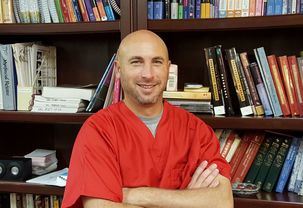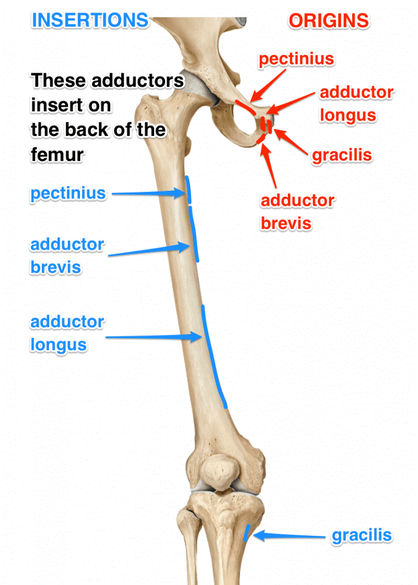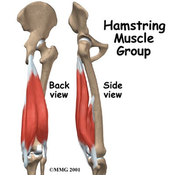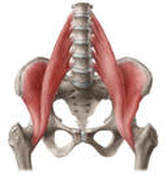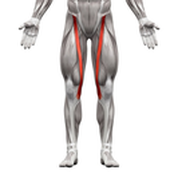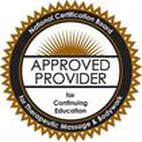
Is a Career in Massage Therapy Your Path? Take the Free Quiz
Dr. Dan Rovin's "Danatomy": An Exploration of the Twenty-five Muscles of the Thigh (Part 4)4/12/2018 This week: Adductors, Group of 5
Let’s Just Call Them All Adductors!
the mid-sagittal line and it is along that line that you find muscles like pectoralis major and latissimus dorsi originating. Both work to adduct the upper extremity. The pelvic midline is what the adductors of the hip use as their origin. The real midline of the pelvis has a fibrocartilage structure, referred to as the pubic symphysis, which acts as a shock absorber between the two pubic bones as they articulate. It is not anchored well enough to be a site of muscle attachment. Instead, the muscles originate directly upon the pubic bone and follow the curvature of the pubis as it becomes the ischium. Interestingly, if you were to view a sagittal slice of the pelvis and thigh that was directly between the ASIS and the pubic symphysis all five adductors would originate on the medial side of the sagittal line that separated the two halves. Not all five adductors are strong. The largest of the five, and arguably the strongest, given its width, girth, and height is adductor magnus. It is so big that it originates from the lower pubis and ischium and inserts the length of linea aspera of the femur and gaps to attach to the medial supracondylar ridge of the femur. It is observably larger than any other hip adductor and properly earns the title of MAGNIFICENT. However, I don’t consider it as “true” of an adductor as adductor longus and brevis. Adductor longus and brevis originate together upon the inferior pubic ramus just below to the pubic tubercle. This is the closest pubic spot to the mid-sagittal line. Adductor longus is superficial to adductor brevis and as its name implies, it is longer than adductor brevis. The femur runs from superior to inferior such that the longer length of adductor longus orients it more vertically compared to adductor brevis. Adductor longus inserts on the lower half of linea aspera. Adductor brevis fibers run relatively transverse compared to adductor longus and adductor magnus and it inserts between the pectineus insertion at the top of linea aspera and the adductor longus insertion. Many professors of anatomy only consider adductor longus, adductor brevis, and adductor magnus as the group of hip adductors. They would teach pectineus and gracilis as synergists of hip adduction. I, on the other hand, would debate that pectineus and gracilis fit the parameters for qualifying as agonists of hip adduction. They both originate at the pelvic midline. Pectineus is shorter and much stronger than gracilis. Pectineus originates from and gets its namesake from the top edge of the superior pubic ramus along a sharp ridge that runs between the pubic tubercle and the eminence where the pubis becomes the ilium. It travels obliquely toward the posterior femur and inserts just above and to the side of linea aspera on what is referred to as the pectineal line. It should be considered, first and foremost a hip adductor. It also medially rotates and flexes the hip. Gracilis also originates from the pubic bone but from the inferior pubic ramus. It is named for its slender appearance. It is the only muscle of this group to insert beyond the femur. It inserts with sartorius and semimembranosus as part of pes anserinus (the goosefoot tendon discussed in previous blogs). Gracilis is the most medial muscle of the thigh and like pectineus, it is a synergist of hip medial rotation. It can also help the hamstring muscles flex the knee. Gracilis is oriented vertically which is not an asset of a hip adductor and, as such, is very weak in adduction. But, none the less, it is a hip adductor. Since all five muscles of the hip adductor group originate together and work as a collective to achieve hip adduction, I propose the following changes to be made:
I doubt that the anatomy communities worldwide will accept these changes. Perhaps one day my reputation as an anatomy instructor will carry clout and the textbooks will show the five adductors as ADDUCTOR PECTINEUS, ADDUCTOR BREVIS, ADDUCTOR LONGUS, ADDUCTOR MAGNUS, and ADDUCTOR GRACILIS. Let’s just call them all adductors!
|
Healing Arts Center News
Keep up with what's happening at the Healing Arts Center.
Follow us on Social Media:Read the Fire Bowl School Newsletter:
Categories
All
|
*The Healing Arts Center is proudly accredited by the Accrediting Commission of Career Schools and Colleges (ACCSC) for the 600-hour massage therapy training certificate only. ACCSC does not accredit individual Master Track courses or CEU offerings separately for this or any institution.
Follow Us Online:
© Copyright, The Center For the Healing Arts, LLC, 2020
